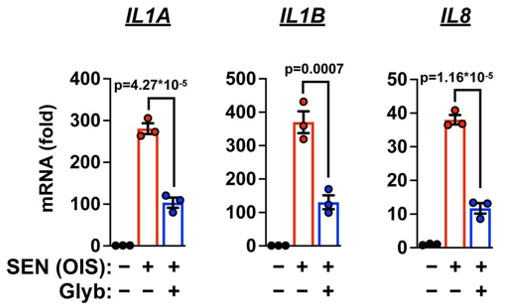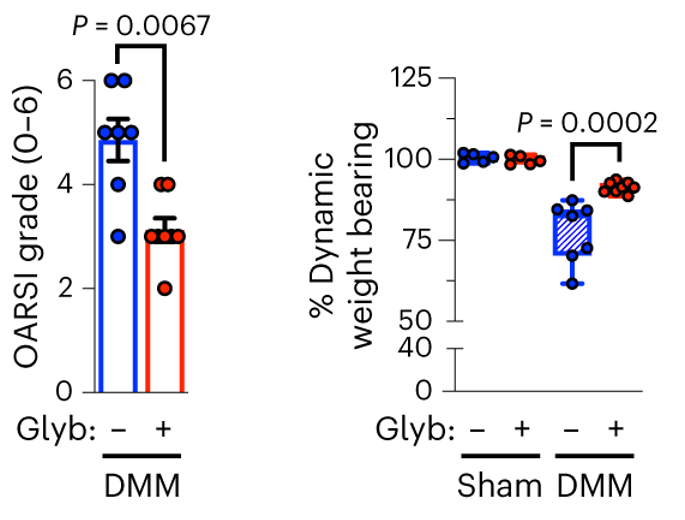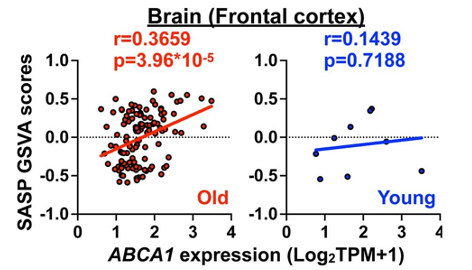Key Points:
- Glyburide reduces age-promoting molecules secreted by human senescent cells called SASP factors.
- Treatment with glyburide reduces cartilage damage and relieves pain in an arthritis mouse model.
- Elevated SASP factors are correlated with aberrant levels of cholesterol transport, which glyburide modulates, in older adults.
The dysregulation of cholesterol is associated with multiple age-related diseases, including cardiovascular disease, Alzheimer’s disease, cancer, osteoporosis, and arthritis (osteoarthritis). However, just how cholesterol dysregulation affects so many diseases is unclear.
Now, researchers from Seoul National University in Korea help elucidate the role of cholesterol in aging with new findings published in Nature Metabolism. Roh and colleagues find that inhibiting cholesterol transport can reduce SASP factor genes in human senescent cells and alleviate arthritis pathology in mice. They also show that altered cholesterol transport is correlated with increased SASP factors in multiple tissues from older individuals.
Inhibiting Cholesterol Transport with Glyburide Reduces SASP and Alleviates Arthritis
When our cells reach the end of their lifespan (replicative senescence) or when they encounter cellular stress such as DNA damage, they become senescent cells. As we age, these senescent cells accumulate in our organs and contribute to aging by secreting what are called SASP factors.
“Chronic inflammation resulting from SASP activation is an integrative hallmark of aging that causes the functional decline associated with various aging-related conditions, including cancer, metabolic syndrome and neurodegenerative diseases,” state the authors of the study.
In human senescent cells, the authors, Roh and colleagues, were able to suppress age-promoting SASP factors by genetically deleting ABCA1, a protein that transports cholesterol out of cells.
ABCA1 belongs to the ABC transporter family of proteins. For this reason, the researchers treated senescent cells with the anti-diabetic drug glyburide, which is an ABC transporter inhibitor. Similar to ABCA1 deletion, glyburide treatment reduced SASP factor gene activation. These findings suggest that glyburide is a senomorphic — compound that reduces SASP factors.

Arthritis is an age-related disease characterized by cartilage degeneration. Recent findings have shown that senescent cells contribute to arthritis. To determine if the senomorphic effect of glyburide could alleviate arthritis pathology, Roh and colleagues injected glyburide into the knee joint of mice after inducing arthritis via damage to the medial meniscus, a band of cartilage.
Glyburide was shown to reduce SASP gene activation and alleviate arthritis progression. Arthritis progression was assessed with the Osteoarthritis Research Society International (OARSI) grading system, which scores the level of cartilage damage. Coinciding with reduced cartilage damage, glyburide also reduced pain. Pain was assessed by how often the arthritis model mice placed weight on the paw of their injured (arthritis) leg. This was measured using specialized floor pressure sensors.

To determine if abnormal cholesterol transport contributes to increased SASP factor secretion in humans, Roh and colleagues assessed gene activation patterns in tissue samples from young (20 to 39 years old) and old (60 to 79 years old) adults. They found that increased ABACA1 levels positively correlated with SASP factor genes in multiple old tissues, including the brain and lung. These findings suggest that altered cholesterol could contribute to aging by promoting SASP factor secretion in multiple organs.

Glyburide as a New Anti-Aging Molecule
In addition to the experiments highlighted above, Roh and colleagues found that ABCA1 increases cholesterol in lysosomes — our cellular waste disposal organelles. The increase in lysosomal cholesterol may activate the nutrient sensor mTOR (the dysregulation of which is a hallmark of aging), which promotes the synthesis of proteins such as the SASP factors. Thus, the authors reveal the nuanced role of cholesterol in age-related diseases like arthritis:
“Our study that unifies these discrete reports of senescence and cholesterol metabolism affecting [arthritis] provides a therapeutic strategy for treating [arthritis] with better precision by modulating lysosomal cholesterol instead of targeting overall cholesterol metabolism.”
While SASP factors contribute to arthritis, they also contribute to many other age-related diseases. This gives glyburide the potential to mitigate these diseases by altering cholesterol transport and reducing SASP factor secretion in tissues other than cartilage. The authors say:
“Our study proposes that senescence, a widely accepted basic aging mechanism, serves as a cellular platform where accumulated cholesterol can exert pro-aging effects via metabolic regulation of senescence-associated inflammation.”